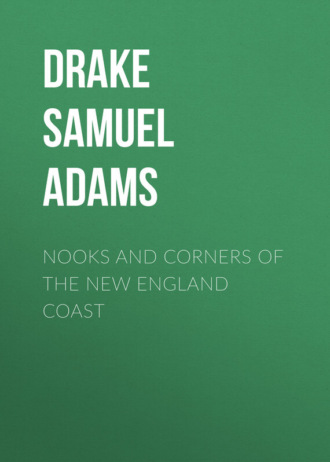 полная версия
полная версияNooks and Corners of the New England Coast
On the beach, below where the martello tower had stood, I discovered many fragments of bricks among the rock débris. Some of these were as large as were commonly used in the hearths of our most ancient houses. The arch by which the tower was perhaps supported remained nearly intact, though completely concealed by a thicket formed of interweaving shrubs. Some have conjectured it to have been a hiding-place of smugglers. Fragments of shot and shell have likewise been picked up among the rubbish of the old fortress. Not far from the spot is a grave-yard, in which time and neglect have done their work.
It has been attempted to show that a large and populous settlement existed from a very early time at Pemaquid, with paved streets and some of the belongings of a permanent population. Within a few years excavations have been made, exhibiting the remains of pavement of beach-pebble at some distance below the surface of the ground.
It is not doubted that a small plantation was maintained here antecedent to the settlement in Massachusetts Bay, but it as certainly lacks confirmation that it had assumed either the proportions or outward appearance of a well and regularly built town at any time during the seventeenth century. If it were true, as Sullivan states, that in 1630 there were, exclusive of fishermen, eighty-four families about Sheepscot, Pemaquid, and St. George's, it also becomes important to know by what means these settlements were depopulated previous to the Indian wars.
The commissioners of Charles II., sent over in 1665, reported that upon the rivers Kennebec, Sheepscot, and Pemaquid were three plantations, the largest containing not more than thirty houses, inhabited, say they, "by the worst of men." The commissioners gave impartial testimony here, for they were trying to dispossess Massachusetts of the government she had assumed over Maine since 1652. They wrote further, that neither Kittery, York, Wells, Scarborough, nor Falmouth had more than thirty houses, and those mean ones. This was the entirety of the grand old Pine-tree State two centuries ago.
Colonel Romer had recommended, about 1699, the fortifying anew of Pemaquid, and the building of supporting works at the next point of land, and on John's Island. Nothing, however, appears to have been done until the arrival of Colonel David Dunbar, in 1730, to resume possession of the Sagadahoc territory in the name of the crown.
Dunbar repaired the old works, giving them the name of Fort Frederick. At Pemaquid Point he laid out the plan of a city which he divided into lots, inviting settlers to repopulate the country. Old grants and titles were considered extinct. His possession at Pemaquid conflicting with the Muscongus patent was revoked through the efforts of Samuel Waldo. The garrison was replaced by Massachusetts troops, and the so-called Sagadahoc territory annexed to the County of York.56
When in the neighborhood, the visitor will feel a desire to inspect the extensive shell heaps of the Damariscotta, about a mile above the town of Newcastle. They occur on a jutting point of land, in such masses as to resemble low chalk cliffs of guano deposits. The shells are of the oyster, now no longer native in New England waters, but once abundant, as these and other remains testify. The highest point of the bank is twenty-five feet above the river. The deposits are rather more than a hundred rods in length, with a variable width of from eighty to a hundred rods. The shells lie in regular layers, bleached by sun and weather. Among the many naturalists who have visited them may be named Dr. Charles T. Jackson,57 and Professor Chadbourne, of Bowdoin College. Some animal remains found among the shells were submitted to Agassiz, who concurred in the received opinion that the shells were heaped up by men.
From point to point excavations have been made with the expectation of finding the Indian implements which have occasionally rewarded such investigations. Williamson mentions a tradition that human skeletons had been discovered in these beds. The bones of animals and of birds have been found in them. Situated in the immediate vicinity of the shell deposits is a kiln for converting the shells into lime, which is produced of as good quality as that obtained from limestone rock.
In walking along the beach at low tide, I had an excellent opportunity of surveying these remains. A considerable growth of trees had sprung from the soil collected above them, the roots of some having penetrated completely through the superincumbent shells to the earth beneath. From an observation of several cavities near the surface and in the sides of the oyster banks, the shells, in some instances, appear to have been subjected to fire. The entire stratum was in a state of decomposition that sufficiently attests the work of years. Even those shells lying nearest the surface in most cases crumbled in the hands, while at a greater depth the closely-packed valves were little else than a heap of lime.
The shell heaps are of common occurrence all along the coast. The reader knows them for the feeding-places of the hordes preceding European civilization. Here they regaled themselves on a delicacy that disappeared when they vanished from the land. The Indians not only satisfied present hunger, but dried the oyster for winter consumption. Their summer camps were pitched in the neighborhood of well-known oyster deposits, the squaws being occupied in gathering shell-fish, while the men were engaged in fishing or in hunting.
Josselyn mentions the long-shelled oysters peculiar to these deposits. He notes them of nine inches in length from the "joint to the toe, that were to be cut in three pieces before they could be eaten." Wood professes to have seen them of a foot in length. I found many of the shells here of six inches in length. Winthrop alludes to the oyster banks of Mystic River, Massachusetts, that impeded its navigation. During recent dredgings here oyster-shells of six to eight inches in length were frequently brought to the surface. The problem of the oyster's disappearance is yet to be solved.58
CHAPTER VII.
MONHEGAN ISLAND
"From gray sea-fog, from icy drift,From peril and from pain,The home-bound fisher greets thy lights,Oh hundred-harbored Maine!"Whittier.The most famous island you can find on the New England map is Monhegan Island. To it the voyages of Weymouth, of Popham, and of Smith converge. The latter has put it down as one of the landmarks of our coast. Rosier calls it an excellent landfall. It is undoubtedly Monhegan that is seen on the oldest charts of New England. Champlain, with the same aptness and originality recognized in Mount Desert and Isle au Haut, names it La Tortue. Take from the shelf Bradford, Winthrop, Prince, or Hubbard, and you will find this island to figure conspicuously in their pages. Bradford says starving Plymouth was succored from Monhegan as early as 1622. The Boston colonists of 1630 were boarded when entering Salem by a Plymouth man, going about his business at Pemaquid. English fishing ships hovered about the island for a dozen years before the Mayflower swung to her anchorage in the "ice-rimmed" bay. The embers of some camp-fire were always smouldering there.
Sailing once from Boston on a Penobscot steamboat, a few hours brought us up with Cape Ann. I asked the pilot for what land he now steered.
"M'nhiggin."
In returning, the boat came down through the Mussel Ridge Channel like a race-horse over a well-beaten course. We rounded Monhegan again, and then steered by the compass. Monhegan is still a landmark.
A wintry passage is not always to be commended, especially when the Atlantic gets unruly. Leaving the wharf on one well-remembered occasion, we steamed down the bay in smooth water at fourteen miles an hour. All on board were in possession of their customary equipoise. Soon the gong sounded a noisy summons to supper. We descended. The cabin tables were quickly occupied by a merry company of both sexes. There was a clatter of plates and sharp clicking of knives and forks; waiters ran hither and thither; the buzz of conversation and ripple of suppressed laughter began to diffuse themselves with the good cheer, when, suddenly, the boat, mounting a sea, fell off into the trough with a measured movement that thrilled every victim of old Neptune to the marrow.
It would be difficult to conceive a more instantaneous metamorphosis than that which now took place. Maidens who had been chatting or wickedly flirting, laid down their knives and forks and turned pale as their napkins. Youths that were all smiles and attention to some adorable companion suddenly behaved as if oblivious of her presence. Another plunge of the boat! My vis-à-vis, an old gourmand, had intrenched himself behind a rampart of delicacies. He stops short in the act of carving a fowl, and reels to the cabin stairs. Soon he has many followers. Wives are separated from husbands, the lover deserts his mistress. A heavier sea lifts the bow, and goes rolling with gathered volume astern, accompanied by the crash of crockery and trembling of the chandeliers. That did the business. The commercial traveler who told me he was never sea-sick laid down the morsel he was in the act of conveying to his mouth. He tried to look unconcerned as he staggered from the table, but it was a wretched failure. Two waiters, each bearing a well-laden tray, were sent sliding down the incline to the leeward side of the cabin, where, coming in crashing collision, they finally deposited their burdens in a berth in which some unfortunate was already reposing. All except a handful of well-seasoned voyagers sought the upper cabins, where they remained pale as statues, and as silent. The rows of deserted seats, unused plates, the joints sent away untouched, presented a melancholy evidence of the triumph of matter over mind.
Early in the morning we made out Monhegan, as I have no doubt it was descried from the mast-head of the Archangel, Weymouth's ship, two hundred and seventy years ago. The sea was shrouded in vapor, so that we saw the island long before the main-land was visible. Sea-faring people call it high land for this part of the world.
Near the westward shore of the southern half of this remarkable island is a little islet, called Mananas, which forms the only harbor it can boast. Captain Smith says, "Between Monahiggon and Monanis is a small harbour, where we rid." The entrance is considered practicable only from the south, though the captain of a coasting vessel pointed out where he had run his vessel through the ragged reefs that shelter the northern end, and saved it. It was a desperate strait, he said, and the by-standers shook their heads, in thinking on the peril of the attempt.59
The inhabitants are hospitable, and many even well to do. Their harbor is providentially situated for vessels that are forced on the coast in heavy gales, and are able to reach its shelter. At such times exhausted mariners are sure of a kind reception, every house opening its doors to relieve their distresses. Having all the requirements of snug harboring, excellent rock fishing, with room enough for extended rambling up and down, the island must one day become a resort as famous as the Isles of Shoals. At present there is a peculiar flavor of originality and freshness about the people, who are as yet free from the money-getting aptitudes of the recognized watering-place.
George Weymouth made his anchorage under Monhegan on the 18th of May, 1605. "It appeared," says Rosier, "a mean high land, as we afterward found it, being an island of some six miles in compass, but, I hope, the most fortunate ever yet discovered. About twelve o'clock that day, we came to an anchor on the north side of this island, about a league from the shore. About two o'clock our captain with twelve men rowed in his ship-boat to the shore, where we made no long stay, but laded our boat with dry wood of old trees upon the shore side, and returned to our ship, where we rode that night." * * *
"This island is woody, grown with fir, birch, oak, and beech, as far as we saw along the shore; and so likely to be within. On the verge grow gooseberries, strawberries, wild pease, and wild rose-bushes. The water issued forth down the cliffs in many places; and much fowl of divers kinds breeds upon the shore and rocks."
The main-land possessed greater attraction for Weymouth. Thinking his anchorage insecure, he brought his vessel the next day to the islands "more adjoining to the main, and in the road directly with the mountains, about three leagues from the island where he had first anchored."
I read this description while standing on the deck of the Katahdin, and found it to answer admirably the conditions under which I then surveyed the land. We were near enough to make out the varied features of a long line of sea-coast stretching northward for many a mile. There were St. George's Islands, three leagues distant, and more adjoining to the main. And there were the Camden Mountains in the distance.60
Weymouth landed at Pemaquid, and traded with the Indians there. In order to impress them with the belief that he and his comrades were supernatural beings, he caused his own and Hosier's swords to be touched with the loadstone, and then with the blades took up knives and needles, much mystifying the simple savages with his jugglery. It took, however, six whites to capture two of the natives, unarmed and thrown off their guard by feigned friendship.
But one compensation can be found for Weymouth's treachery in kidnaping five Indians here, and that is in the assertion of Sir F. Gorges that this circumstance first directed his attention to New England colonization. At least two of the captive Indians found their way back again. One returned the next year; another – Skitwarres – came over with Popham. A strange tale these savages must have told of their adventures beyond seas.61
Some credence has been given to the report of the existence of a rock inscription on Monhegan Island, supposed by some to be a reminiscence of the Northmen. The Society of Northern Antiquaries of Copenhagen has reproduced it in their printed proceedings. The best informed American antiquaries do not believe it to possess any archæological significance. I also heard of another of the "devil's foot-prints" on Mananas, but did not see it.
Between Monhegan and Pemaquid Point was the scene of the sea-fight between the Enterprise and Boxer. Some of the particulars I shall relate I had of eye-witnesses of the battle.
In September, 1814, the American brig Enterprise quitted Portsmouth roads. She had seen service in the wars with the French Directory and with Algiers. She had been rebuilt in 1811, and had already gained the name of a lucky vessel. Her cruising-ground was along the Maine coast, where a sharp lookout was to be kept for privateers coming out of the enemy's ports. In times past her commanders were such men as Sterrett, Hull, Decatur, and Blakely, in whom was no more flinching than in the mainmast.
Lieutenant Burrows, who now took her to sea, had been first officer of a merchant ship and a prisoner to the enemy. As soon as exchanged he was given the command of the Enterprise. He was a good seaman, bound up in his profession, and the darling of the common sailors. Taciturn and misanthropic among equals, he liked to disguise himself in a pea-jacket and visit the low haunts of his shipmates. It was believed he would be killed sooner than surrender.
The Boxer had been fitted out at St. Johns with a view of meeting and fighting the Enterprise. Every care that experience and seamanship could suggest had been bestowed upon her equipment. She was, moreover, a new and strong vessel. In armament and crews the two vessels were about equal, the inferiority, if any, being on the side of the American. The two brigs were, in fact, as equally matched as could well be. They were prepared, rubbed down, and polished off, like pugilists by their respective trainers. They were in quest of each other. The conquered, however, attributed their defeat to every cause but the true one, namely, that of being beaten in a fair fight on their favorite element.
The Boxer, after worrying the fishermen, and keeping the sea-coast villages in continual alarm, dropped anchor in Pemaquid Bay on Saturday, September 4th, 1814. There was then a small militia guard in old Fort Frederick. The inhabitants of Pemaquid Point, fearing an attack, withdrew into the woods, where they heard at evening the music played on board the enemy's cruiser.
The next morning, a peaceful Sabbath, the lookout of the Boxer made out the Enterprise coming down from the westward with a fair wind. In an instant the Briton's decks were alive with men. Sails were let fall and sheeted home with marvelous quickness, and the Boxer, with every rag of canvas spread, stood out of the bay. From her anchorage to the westward of John's Island, the Boxer, as she got under way, threw several shot over the island into the fort by way of farewell. Both vessels bore off the land about three miles, when they stripped to fighting canvas. The American, being to windward, had the weather-gage, and, after taking a good look at her antagonist, brought her to action at twenty minutes past three o'clock in the afternoon. Anxious spectators crowded the shores; but after the first broadsides, for the forty minutes the action continued, nothing could be seen except the flashes of the guns; both vessels were enveloped in a cloud. At length the firing slackened, and it was seen the Boxer's maintop-mast had been shot away. The battle was decided.
This combat, which proved fatal to both commanders, was, for the time it lasted, desperately contested. The Enterprise returned to Portland, with the Boxer in company, on the 7th. The bodies of Captain Samuel Blythe, late commander of the English brig, and of Lieutenant William Burrows, of the Enterprise, were brought on shore draped with the flags each had so bravely defended. The same honors were paid the remains of each, and they were interred side by side in the cemetery at Portland. Blythe had been one of poor Lawrence's pall-bearers.
This was the first success that had befallen the American navy since the loss of the Chesapeake. It revived, in a measure, the confidence that disaster had shaken. The Boxer went into action with her colors nailed to the mast – a useless bravado that no doubt cost many lives. Her ensign is now among the trophies of the Naval Academy at Annapolis, while that of the Enterprise has but lately been reclaimed from among the forgotten things of the past, to array its tattered folds beside the flags of the Bonhomme Richard and of Fort M'Henry.62
Among the recollections of his "Lost Youth," the author of "Evangeline," a native of Portland, tells us:
"I remember the sea-fight far away,How it thundered o'er the tide!And the dead captains, as they layIn their graves o'erlooking the tranquil bay,Where they in battle died."CHAPTER VIII.
FROM WELLS TO OLD YORK
"A shipman was there, wonned far by west;For aught I wot, he was of Dartëmouth."Chaucer.One hot, slumberous morning in August I found myself in the town of Wells. I was traveling, as New England ought to be traversed by every young man of average health and active habits, on foot, and at leisure, along the beautiful road to Old York. Now Wells, as Victor Hugo says of a village in Brittany, is not a town, but a street, stretching for five or six miles along the shore, and everywhere commanding an extensive and unbroken ocean view.
The place itself, though bristling with history, has been stripped of its antiques, and is in appearance the counterpart of a score of neat, thrifty villages of my acquaintance. I paused for a moment at the site of the Storer garrison, in which Captain Converse made so manful a defense when Frontenac, in 1692, let slip his French and Indians on our border settlements.63 Some fragments of the timbers of the garrison are preserved in the vicinity, one of which I saw among the collections of a village antiquary. In the annals of Wells the names of John Wheelwright and of George Burroughs occur, the former celebrated as the founder of Exeter, the latter a victim of the witchcraft horror of '92.
John Wheelwright, the classmate and friend of Cromwell, fills a large space in the early history of the Bay Colony. A fugitive, like John Cotton, from the persecutions of Laud, he came to Boston in 1636, and became the pastor of a church at Braintree, then forming part of Boston. He was the brother-in-law of the famous Ann Hutchinson, who was near creating a revolution in Winthrop's government,64 and shared her Antinomian opinions. For this he was banished, and became the founder of Exeter in 1638. In 1643, Massachusetts having claimed jurisdiction over that town, Wheelwright removed to Wells, where he remained two years. Becoming reconciled to the Massachusetts government, he removed to Hampton, was in England in 1657, returning to New England in 1660. He became pastor of the church in Salisbury, and died there in 1679; but the place of his burial, Allen says, is not known. He was the oldest minister in the colony at the time of his death, and a man of pronounced character. The settlement of the island of Rhode Island occurred through the removal of William Coddington and others at the same time, and for the same reasons that caused the expulsion of Wheelwright from Boston, as Roger Williams had been expelled from Salem seven years before.
"Wheelwright's Deed" has been the subject of a long and animated controversy among antiquaries; some, like Mr. Savage, pronouncing it a forgery because it is dated in 1629, the year before the settlement of Boston. This deed was a conveyance from the Indian sagamores to Wheelwright of the land on which stands the flourishing town of Exeter; and although copies of it have been recorded in several places, the original long ago disappeared. Cotton Mather, who saw it, testifies to its appearance of antiquity, and the advocates of its validity do not appear as yet to have the worst of the argument.65
George Burroughs, who fell fighting against terrorism on Gallows Hill – a single spot may claim in New England the terrible distinction of this name – was, if tradition says truly, apprehended by officers of the Bloody Council at the church door, as he was leaving it after divine service. A little dark man, and an athlete, whose muscular strength was turned against him to fatal account. An Indian, at Falmouth, had held out a heavy fowling-piece at arms-length by simply thrusting his finger in at the muzzle. Poor Burroughs, who would not stand by and see an Englishman outdone by a redskin, repeated the feat on the spot, and this was the most ruinous piece of evidence brought forth at his trial. A man could not be strong then, or the devil was in it.
The road was good, and the way plain. As the shores are for some miles intersected by creeks intrenched behind sandy downs, the route follows a level shelf along the high land. There are pleasant strips of beach, where the sea breaks noiselessly when the wind is off shore, but where it comes thundering in when driven before a north-east gale. Now and then a vessel is embayed here in thick weather, or, failing to make due allowance for the strong drift to the westward, is set bodily on these sands, as the fishermen say, "all standing." While I was in the neighborhood no less than three came ashore within a few hours of each other. The first, a timber vessel, missing her course a little, went on the beach; but at the next tide, by carrying an anchor into deep water and kedging, she was floated again. Another luckless craft struck on the rocks within half a mile of the first, and became a wreck, the crew owing their lives to a smooth sea. The third, a Bank fisherman, was left by the ebb high up on a dangerous reef, with a hole in her bottom. She was abandoned to the underwriters, and sold for a few dollars. To the surprise even of the knowing ones, the shrewd Yankee who bought her succeeded at low tide in getting some empty casks into her hold, and brought her into port.
Notwithstanding these sands are hard and firm as a granite floor, they are subject to shiftings which at first appear almost unaccountable. Many years ago, while sauntering along the beach, I came across the timbers of a stranded vessel. So deeply were they imbedded in the sand, that they had the appearance rather of formidable rows of teeth belonging to some antique sea-monster than of the work of human hands. How long the wreck had lain there no one could say; but at intervals it disappeared beneath the sands, to come to the surface again. I have often walked over the spot where it lay buried out of sight; and yet, after the lapse of years, there it was again, like a grave that would not remain closed.











